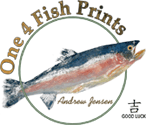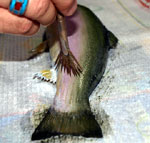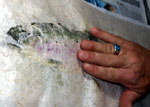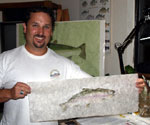
 |
|
 |
|
IN THE NEWS
|
 |
||
Artist
Andrew Jensen gave me an opportunity to watch him create a Gyotaku,
Japanese fish print, on a recent tour of his studio. |
|||
 |
Andrew, I must admit that it’s a funny thing to come into your studio and see a fish on your table. What kind of reaction do you get from the public about the artwork you do? First response is usually, “No way, that’s
a real fish?” Most people, especially kids, are fascinated
with the process of fish printing. Of course there is the occasional
person that says, “That is gross” or “Pew, that
fish stinks.” That makes it more fun. |
||
If I remember correctly, fish printing has ancient origins. Tell us about how fish printing started. Gyotaku (pronounced ghee-oh-tah-koo) is the Japanese art of fish printing. “Gyo” = fish, and “Taku” = impression. It originated in Japan over 100 years ago as a way to record trophy catches. Today, Gyotaku are said to bring good luck to fishermen. I use the direct Gyotaku method: Paints are applied directly to a fish and acid-free paper or fabric is carefully pressed onto the fish. When the paper is lifted, a detailed mirror-image fish print is revealed. Each print is one-of-a-kind. |
 |
||
| You really treat the fish like a canvas. What are some of the painting tricks to get a good print? It is an amazing process to paint a real fish and attempt to replicate the natural coloration patterns. There is always an artistic variation to each print, but I attempt to capture the natural colorations of each species. A trick to a better quality print is to paint the fish from head to tail, in the direction with the scales. Once the paint is applied, brush lightly from tail to head. This helps lay the paint down into the scales and results in a print that shows the natural scale pattern. |
|||
 |
Do you use any kind of special paint? Also tell us about your cool brushes. And wow, all the beautiful paper. A few years ago I switched from messy oil-based
paints to water-based oils, which dry slowly just like the normal
oil-based paints but clean up with water. No more paint thinner
and nasty smelling chemicals. It only takes water to wash the fish
and brushes clean. I have also been experimenting with non-toxic
block ink paints. |
||
| The fan brushes work well for applying the paint to the fish, and to achieve a natural blended coloration. I use very small brushes for the intricate process of painting the eyes. I use a wide variety of unusual acid-free papers like banana fiber paper, mango-leaf paper, and unryu paper. The various colors and textures of the papers really make for a more interesting finished print. I’d imagine that the actual printing
is the hard part. Any secrets to getting a good print? |
|||
The impression step is”make it or break it.” Sometimes all goes well, the paint lifts onto the paper well and the structure of the fish is accurately captured on the paper. Other times, the paint does not transfer, the mouth looks too big, the head is disproportionate or the fish print is not positioned on the paper correctly. It can be frustrating, but from each failure I learn. Once I lay the paper on the fish, I slowly and carefully use my fingers to “rub,” and make sure to pull the paint from the fish onto the paper. |
 |
||
How many fish get painted before you get a print you really like? It depends on the species of fish and weather. Some species are easier to work with. If it is cooler, I will have more time to capture the print. In general, for every 10 prints I make, five or six are sell-able, two or three are good for gifts to friends, and two or three don’t make the cut. See Andrew’s Gyotaku at the Brown Trout Gallery in Dunsmuir and through August at ERA Select Realty, 1110 Shasta Street in Redding. For more information about Andrew and Gyotaku, visit one4fishprints.com. |
|||
 |
Adam
Mankoski is a recent North State transplant who feels completely
at home here. He enjoys experiencing and writing about the people,
places and things that embody the free spirit of the State of Jefferson.
He and his partner own HawkMan
Studios and are the creators of Redding’s 2nd
Saturday ArtHop. |
||
|
|
|
| home | fish printing shop | about fish printing | about the artist | photo gallery | resources | contact artist |
